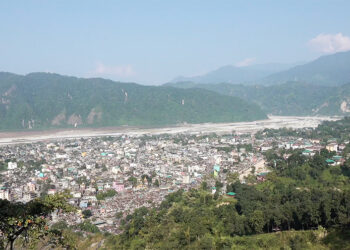 The Lhop community along the Amo Chhu valley in Samtse have been living in huts made of bamboo from time immemorial. Untouched by developmental activities elsewhere, the Lhops were left behind. To alleviate the livelihood of the Lhops at Ngawang Dramtoe (Thongsa), the Tarayana Foundation stepped-in with their housing project.
The Lhop community along the Amo Chhu valley in Samtse have been living in huts made of bamboo from time immemorial. Untouched by developmental activities elsewhere, the Lhops were left behind. To alleviate the livelihood of the Lhops at Ngawang Dramtoe (Thongsa), the Tarayana Foundation stepped-in with their housing project.
Until recently, the Lhops of lower Amo Chhu valley in Ngawang Dramtoe continued with their tribal lifestyle, which was along the poverty line. Raised a meter or two from the ground, the huts where they live are no bigger than a small bus. Usually housing five people, it provides no protection from natural elements like rain and wind.
“Before Tarayana came in all the Lhops were staying in small makeshift huts. We are all poor, no one could afford to construct bigger and better houses,” said Tshechu Doya, from Ngawang Dramtoe (Thongsa) in Tading Gewog, Samtse.
Poor house condition means poor health and sanitation. This also led to not having the will to improve their livelihood. Among many other social issues, Tarayana Foundation picked housing to assist the Lhops of Ngawang Dramtoe.
 “In that small hut, there are several family members. The parents, son and wife and their children all sleep in the same room. This doesn’t seem right for us to see and even they themselves say that it is uncomfortable. They eat, live and sleep in the same place, unlike other places where people have a kitchen, sitting room and bedrooms,” said Thinley Bidha, the Field Officer for Tarayana Foundation.
“In that small hut, there are several family members. The parents, son and wife and their children all sleep in the same room. This doesn’t seem right for us to see and even they themselves say that it is uncomfortable. They eat, live and sleep in the same place, unlike other places where people have a kitchen, sitting room and bedrooms,” said Thinley Bidha, the Field Officer for Tarayana Foundation.
“With Tarayana’s support, a lot of people have now constructed proper houses. Tarayana gave us CGI sheets, funds for making planks and all. This way we could construct our own houses,” Tshechu Doya added.
Each household was given Nu 24,000 as labour charges along with cement and nails. The foundation also assists people with permit formalities. An addition of about Nu 150,000 needs to be borne by the people themselves.
“Once people have a proper house, they will have more needs. A will to have more in their secured house. Then they start working. Also, there is security to leave their spouses and children at home. This gives them the impetus to earn a living. Helping themselves to improve their living standard,” added Thinley Bidha.
“We were unaware before but now we know, and that is why most are keeping their surroundings clean and starting to live a healthy life,” said Tshechu Doya.
There were no skilled masons or carpenters in the community. Everything had to be taught posing more challenges. Of the initial target to help construct 200 houses, 131 have been completed.
“We are willing to do more with people guiding us. We won’t say we won’t do this and that. The Queen Mother has been very gracious to us. Whatever they command we will do, this is going to ultimately benefit us,” said Sona Tobgay Doya, from Ngawang Dramtoe under Tading Gewog in Samtse.
Having a secure shelter is a new beginning for the Lhop community. A house is the starting point to reduce other social issues like school dropouts, teenage pregnancies, and divorce cases.
Sherub Dorji





